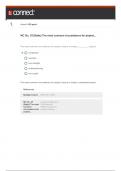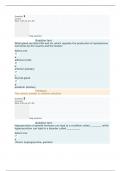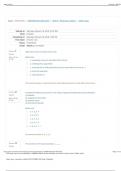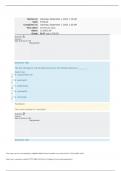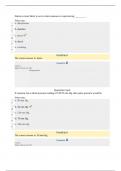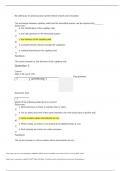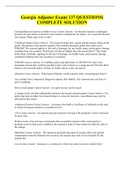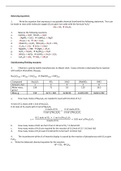East Georgia College
Latest uploads at East Georgia College. Looking for notes at East Georgia College? We have lots of notes, study guides and study notes available for your school.
-
10
- 0
-
2
All courses for East Georgia College
Latest notes & summaries East Georgia College
MC Qu. 01 (Static) The most common circumstance for project... The most common circumstance for project closure is simply a ________ project. completed overdue over-budget underachieving successful The most common circumstance for project closure is simply a completed project. References Multiple Choice Difficulty: 1 Easy MC Qu. 01 (Static) The most common circumstance for project... Learning Objective: 14-01 Identify different types of project closure. ...
What gland secretes FSH and LH, which regulate the production of reproductive hormones by the ovaries and the testes? Select one: a. adrenal cortex b. anterior pituitary c. thyroid gland d. posterior pituitary Feedback The correct answer is: anterior pituitary Question 2 Incorrect Mark 0.00 out of 1.00 Flag question Question text Hyposecretion of growth hormone can lead to a condition called _________, while hypersecretion can lead to a disorder called ___________. Select one...
Select the correct answer explaining why the stomach does not digest itself. Select one: a. The stomach wall lacks proteins so enzymes won't attack it. b. The stomach lining is too tough to be digested. c. The digestive enzymes in the stomach aren't efficient enough. d. The stomach is protected by HCl. e. The stomach wall is protected by large amounts of mucus. Feedback The correct answer is: The stomach wall is protected by large amounts of mucus. Question 2 Incorrect Mark 0.00 out...
In relation to homeostasis, explain why a person with toxic goiter tends to sweat profu
Select the correct function of the nose. Select one: a. producing mucus to trap debris from the air b. initiating the cough reflex c. warming the air and producing mucus to trap debris from the air ! d. external respiration e. warming the air The correct answer is: warming the air and producing mucus to trap debris from the air Arrange the following structures in the order air passes through them during inhalation: (1) alveolus (2) respiratory bronchiole (3) alveolar ducts (4) termin...
Which of the following are considered primary lymphatic organs? Select one: a. thymus and lymph nodes b. red bone marrow and lymph nodes c. red bone marrow and thymus d. tonsils and spleen
Edema is most likely to occur when someone is experiencing _________. Select one: a. dehydration b. diarrhea c. burns d. shock e. vomiting Feedback The correct answer is: burns Question 2 Correct Mark 1.00 out of 1.00 Flag question Question text If someone has a blood pressure reading of 120/70 mm Hg, their pulse pressure would be Select one: a. 90 mm Hg. b. 50 mm Hg.
The exchange between capillary walls and the interstitial spaces can be improved by _______ Select one: a. the stratification of the capillary wall b. the high pressure in the interstitial spaces c. the thinness of the capillary wall d. increased blood velocity through the capillaries e. minimal branching in the capillary bed Feedback The correct answer is: the thinness of the capillary wall
Consequential also known as Indirect Loss Correct Answer: An insured's business is damaged because of a fire and he is forced to close business temporarily for repairs. As a result the insured lost income. What type of loss is this? Combined Single Correct Answer: The insured crashes into a porch and the person sitting on the porch. The person on the porch is injured. The insured's insurance policy has a limit set at $500,000. This amount applies to the total of damages for any bodily injury ...
1. Write the equation that expresses in acceptable chemical shorthand the following statement: “Iron can be made to react with molecular oxygen (O2) to give iron oxide with the formula Fe2O3” 4Fe + 3O2 2Fe2O3 2. Balance the following reactions: a. Ca(OH)2 + 2HCl CaCl2 + 2H2O b. 2AgNO3 + CaCl2 Ca(NO3)2 + 2AgCl c. 2Fe2O3 + 3C 4Fe + 3CO3 d. 2NaHCO3 + H2SO4 Na2SO4 + 2H2O + 2CO2 e. 2C4H10 + 13O2 8CO2 + 10H2O f. Mg(OH)2 + 2HBr MgBr2 + 2H2O g. Al2O3 ...

